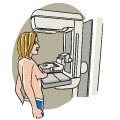Description of the test
A mammogram tests for breast cancer in the breast tissue and areas surrounding the breast. Mammography machines provide X-ray images of the breast. Mammograms are performed in a clinic, hospital, or other facility with the necessary mammography equipment.
Breast cancer is the most common type of cancer diagnosed in Canadian women. It makes up about 26% of all newly-diagnosed cancers in women. About half of all breast cancer cases occur in women between the ages of 50 and 69. However, women of all ages need to be aware of how they can prevent and treat breast cancer.
Although their risk of breast cancer is lower, men also develop a number of cases of breast cancer each year.
How often should the test be performed?
Testing usually begins around the age of 50. All women between the ages of 50 and 74 should have a mammogram every 2 to 3 years. Depending on your family history of breast cancer or other risk factors for breast cancer, your doctor might recommend earlier or more frequent testing.
Why is this test performed?
Breast cancer may lead to serious complications and death if it is not treated. Because the mammogram allows early detection, it is a very important tool in the fight against breast cancer. Detecting breast cancer early on makes early treatment possible and increases the chance of survival.
Are there any risks and precautions?
The level of radiation used in this test is low; therefore, the risk of damage to cells is also very low. Although repeated exposure to X-rays increases the risk of developing cancer, the benefits of finding breast cancer early outweigh this risk.
If you are or may be pregnant, tell your doctor or the person performing the test. Mammograms are not routinely done in pregnant women due to concerns of fetal exposure to radiation, but it is generally accepted that the radiation dose to the ovaries and fetus are low. Nevertheless, you should discuss this with your physician. If a mammogram is still necessary, a lead shield can be placed over the pelvic area to reduce the exposure to the radiation from the X-rays. Also, the accuracy of the mammogram may be slightly lower during pregnancy due to the ongoing changes in the breast.
To ensure the most accurate results, try to follow instructions closely. Stay still if the technician asks you to remain motionless. If you move, the image will not be clear.
What happens during the test?
You first need to remove any jewellery and metal objects as well as clothing above the waist and put on a hospital gown. If you are wearing lotion or deodorant on or around the breasts and armpits, rinse it off. Store your personal belongings safely.
You will usually be asked to stand (although some tests are done while you are sitting or lying down) while a radiology technologist or another health care professional places one of your breasts on a flat surface. Another surface pushes against the breast to make the tissue flat. Two pictures will be taken of each breast, one with the breast compressed from top to bottom and the other with the breast compressed from side to side.
Try to remain completely still while the pictures are being taken. More pictures may be taken if, for example, a possible abnormality is detected or if an image is unclear. For women with breast implants, special views are obtained to ensure all the breast tissue can be seen.
Most people find a mammogram uncomfortable. Squeezing the breast tissue between the X-ray plate is necessary in order to make the image clearer. The entire procedure should take no more than 30 minutes.
How should I prepare for this test?
Before the breast exam, tell your doctor if you:
- are pregnant or suspect you are pregnant
- have breast implants
On the day of the test, avoid using deodorant or other products on the skin around or on the breasts.
Bring any previous test X-rays of your breasts with you, if you have them. Make sure to tell the person performing the test if you have had any breast surgery in the past (e.g., a breast biopsy, breast implant surgery, or breast reduction surgery), or if you are currently breast-feeding. Scar tissue from a previous surgery can affect the test results.
If you experience breast tenderness before your menstrual period, try to schedule the test for a time when your breasts are not tender.
Tell your doctor or prescriber about all prescription, over-the-counter (non-prescription), and herbal medications that you are taking. Also tell them about any medication allergies and medical conditions that you may have.
Ask your doctor or pharmacist whether you need to stop taking any of your medications before the test.
What can I expect after the test?
Your breasts may be tender after the test. A warm shower may relieve some of this tenderness.
Results
A radiologist interprets the results of a mammogram. You may receive your results immediately after the image is developed, or results may be available several days later.
Your doctor will discuss the results with you and use the mammogram results, along with results from other tests, to determine the next step in your care. You may be asked to return for additional mammograms of one or both breasts. This is a common occurrence and does not necessarily mean that a serious abnormality has been detected.
All material copyright MediResource Inc. 1996 – 2024. Terms and conditions of use. The contents herein are for informational purposes only. Always seek the advice of your physician or other qualified health provider with any questions you may have regarding a medical condition. Source: www.medbroadcast.com/procedure/getprocedure/Mammogram

A woman undergoing a mammogram test






